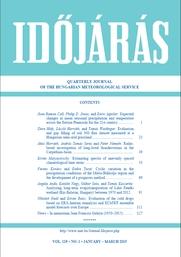IDŐJÁRÁS - angol nyelvű folyóirat
Vol. 119, No. 1 * Pages 1–128 * Januar - March 2015
 |
|
Expected changes in mean seasonal precipitation and temperature across the Iberian Peninsula for the 21st century
Joan Ramon Coll, Philip D. Jones and Enric Aguilar
idojaras.2015.1.1 (p. 1–)
Joan Ramon Coll, Philip D. Jones and Enric Aguilar
idojaras.2015.1.1 (p. 1–)
Evaluation and gap filling of soil NO flux dataset measured at a Hungarian semi-arid grassland
Dóra Hidy, László Horváth, and Tamás Weidinger
idojaras.2015.1.2 (p. 23–)
Dóra Hidy, László Horváth, and Tamás Weidinger
idojaras.2015.1.2 (p. 23–)
Radar-based investigation of long-lived thunderstorms in the Carpathian Basin
Ákos Horváth, András Tamás Seres, and Péter Németh
idojaras.2015.1.3 (p. 39–)
Ákos Horváth, András Tamás Seres, and Péter Németh
idojaras.2015.1.3 (p. 39–)
Estimating spectra of unevenly spaced climatological time series
István Matyasovszky
idojaras.2015.1.4 (p. 53–)
István Matyasovszky
idojaras.2015.1.4 (p. 53–)
Cyclic variation in the precipitation conditions of the Mátra-Bükkalja region and the development of a prognosis method
Ferenc Kovács and Endre Turai
idojaras.2015.1.5 (p. 69–)
Ferenc Kovács and Endre Turai
idojaras.2015.1.5 (p. 69–)
Analyzing long-term evapotranspiration of Lake Fenéki wetland (Kis-Balaton, Hungary) between 1970 and 2012
Angéla Anda, Katalin Nagy, Gábor Soós, Tamás Kucserka
idojaras.2015.1.6 (p. 91–)
Angéla Anda, Katalin Nagy, Gábor Soós, Tamás Kucserka
idojaras.2015.1.6 (p. 91–)
Evaluation of the cold drops based on ERA-Interim reanalysis and ECMWF ensemble model forecasts over Europe
Nikolett Gaál and István Ihász
idojaras.2015.1.7 (p. 111–)
Nikolett Gaál and István Ihász
idojaras.2015.1.7 (p. 111–)
News: IN MEMORIAM JEAN-FRANÇOIS GELEYN (1950-2015)
András Horányi and Gábor Radnóti
idojaras.2015.1.8
András Horányi and Gábor Radnóti
idojaras.2015.1.8
IDŐJÁRÁS folyóirat

Az IDŐJÁRÁS a HungaroMet Nonprofit Zrt. negyedévenként megjelenő angol nyelvű folyóirata
Megrendelhető a journal.idojaras@met.hu címen.
A szerzőknek szánt útmutató itt olvasható.
Megrendelhető a journal.idojaras@met.hu címen.
A szerzőknek szánt útmutató itt olvasható.









